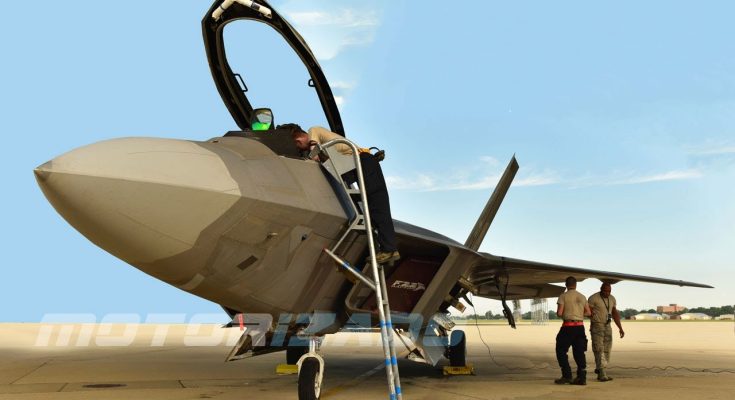F-22 Raptor and T-38 Talon Take Off: A Powerful Display of U.S. Air Force Capability
The F-22 Raptor and T-38 Talon are two iconic aircraft in the United States Air Force (USAF), serving distinct roles but demonstrating the broad spectrum of air combat capability that the U.S. military possesses. When these two aircraft take off together, it is a powerful showcase of the Air Force’s ability to perform both cutting-edge combat missions and rigorous pilot training. The contrasting roles of these aircraft highlight the balance between operational superiority and the need for extensive pilot preparation.
F-22 Raptor: The Apex of Air Superiority
The F-22 Raptor, developed by Lockheed Martin, is a fifth-generation stealth fighter designed primarily for air superiority. It combines advanced stealth capabilities, supercruise ability (the ability to fly at supersonic speeds without using afterburners), and superior avionics. The aircraft is built for dominance in the skies, capable of defeating the most advanced enemy fighters while evading detection.
- Role: Air Superiority, Multirole Fighter (air-to-air, air-to-ground)
- Crew: 1
- Length: 62 feet (18.9 meters)
- Wingspan: 44.5 feet (13.6 meters)
- Top Speed: Mach 2.25 (1,500 mph or 2,414 km/h)
- Combat Radius: 460 miles (740 km)
- Armament: 1 x M61A2 Vulcan gun (20mm), AIM-120 AMRAAM, AIM-9 Sidewinder
- Stealth Features: Advanced radar-absorbing materials and radar-evading design, making it nearly invisible to enemy radar systems.
When the F-22 takes off, it demonstrates its remarkable agility and maneuverability, aided by its thrust vectoring nozzles, which allow for extreme angles of attack and unparalleled control in dogfights. The jet’s supercruise ability allows it to engage and neutralize adversaries at supersonic speeds without relying on the fuel-guzzling afterburners typically used by older generation aircraft. This makes the F-22 a standout when it comes to both performance and efficiency during missions.
In terms of operational readiness, the F-22 is ideal for a range of missions, from air-to-air combat to strategic reconnaissance, and it serves as the backbone of the U.S. Air Force’s air superiority.
T-38 Talon: The Backbone of U.S. Air Force Pilot Training
The T-38 Talon, by contrast, is a highly versatile, twin-engine jet trainer aircraft that has been in service with the U.S. Air Force since 1961. While it is not a frontline fighter like the F-22, the T-38 plays a crucial role in preparing pilots for the demands of modern combat aircraft.
- Role: Advanced Pilot Training
- Crew: 2 (pilot and student)
- Length: 46 feet (14 meters)
- Wingspan: 25 feet (7.6 meters)
- Top Speed: Mach 1.5 (1,000 mph or 1,609 km/h)
- Combat Radius: 500 miles (805 km)
- Armament: None (used strictly for training purposes)
The T-38 Talon is used primarily for advanced flight training, preparing pilots for high-performance aircraft such as the F-22, F-35, and other U.S. fighter jets. Pilots undergo rigorous training in the T-38 to develop key skills, including aerial maneuvers, formation flying, and cockpit resource management.
The T-38’s design makes it ideal for training, with a high-performance, low-cost platform that allows student pilots to experience the characteristics of fighter jets, without the expense or complexity of full-fledged combat aircraft. The T-38’s speed, agility, and ease of handling provide an excellent foundation for future combat pilots, and its tandem seating configuration allows an instructor to oversee and guide the student’s actions in real-time.
The Takeoff: A Symbol of U.S. Air Force Power
When the F-22 Raptor and T-38 Talon take off together, it’s more than just a simple display of flight; it is a powerful symbol of the U.S. Air Force’s commitment to operational superiority and pilot excellence. The F-22’s takeoff represents the pinnacle of advanced air combat capabilities, while the T-38’s takeoff signifies the foundational training that prepares the next generation of pilots to eventually fly the most advanced fighter jets in the world.
The contrast between these two aircraft showcases the multifaceted nature of modern air operations. The F-22, with its high-tech systems and unmatched air superiority, is the product of decades of advanced military development. The T-38, on the other hand, represents the Air Force’s commitment to training pilots who will one day operate those very advanced aircraft. Together, they exemplify the evolution of the U.S. Air Force’s capabilities, from advanced fighter jets to cutting-edge training platforms.
Strategic Importance:
- F-22: The Raptor is essential for ensuring air dominance in any conflict, capable of operating in contested airspaces and providing unmatched aerial superiority over any adversary.
- T-38: The Talon, though a training aircraft, plays a pivotal role in maintaining the U.S. Air Force’s edge in aerial combat by ensuring that future pilots are skilled and ready for high-performance aircraft like the F-22.
In essence, the takeoff of the F-22 and T-38 represents a continuous cycle of innovation, training, and operational readiness, crucial for maintaining air superiority and securing U.S. interests globally.



